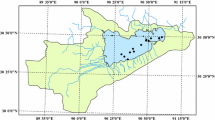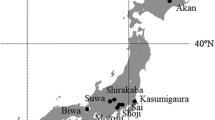Abstract
In the context of remote sensing, sunlight penetration depth is the depth above which 90% of the diffusely reflected irradiance from a water body surface originates. Model algorithms to simulate water quality variables such as chlorophyll a, dissolved organic matter, suspended matter, and Secchi depth are sensitive to the variations of this variable. The penetration depth for Taihu Lake in China, a shallow and turbid lake, was calculated by using a multiple scattering model, and in situ optical measurements were carried out during May and October 2010. The results show that: 1) the penetration depth generally increased from west to east during spring and from southeast to northwest during autumn, reflecting the prevailing wind direction and; 2) there was strong dependence of the penetration depth on the concentration of suspended matter.
Similar content being viewed by others
References
Aurin D A, Dierssen H M. 2012. Advantage and limitations of ocean color remote sensing in CDOM-dominated, mineral-rich coaster and estuarine waters. Remote Sensing of Environment, 125: 181–197.
Bricaud A, Morel A, Prieur L. 1981. Absorption by dissolved organic matter of sea (yellow substance) in the UV and visible domain. Limnology and Oceanography, 26(1): 43–53.
Cao W X, Yang Y Z, Xu X Q. 2003. The absorption spectrum and its area pattern of suspended matter in estuary of Zhu Jiang. Chinese Science Bulletin, 17: 1 876–1 882. (in Chinese with English abstract)
Chen Y W, Chen K N, Hu Y H. 2006. Discussion on possible error for phytoplankton chlorophyll-a concentration analysis using hot-ethanol extraction method. Journal of Lake Sciences, 18(5): 550–552. (in Chinese with English abstract)
Cleveland J S, Weidemann A D. 1993. Quantifying absorptionby aquatic particles: a multiple scattering correction for glass-fiber filters. Limnology and Oceanography, 38(6): 1 321–1 327.
Duan H T, Zhang S X, Zhang Y Z. 2008. Cyanobacteria bloom monitoring with remote sensing in Lake Taihu. Journal of Lake Sciences, 2: 145–152. (in Chinese with English abstract)
Fan C X, Liu Y B, Chen H S. 2000. Approach on estimating storage sludge in Lake Taihu and its distributing characteristics. Shanghai Environmental Sciences, 2: 72–75. (in Chinese with English abstract)
Gordon H R, McCluney W R. 1975. Estimation of depth of sunlight penetration in the sea for remote sensing. Applied Optics, 2: 413–416.
Hommerson A H, Wernand M R, Perter S, Boer J D. 2010. A review on substances and processes relevant for optical remote sensing of extremely turbid marine areas, with a focus on the Wadden Sea. Helgoland Marine Research, 64: 75–92.
Kirk J T O. 1989. The upwelling light stream in natural waters. Limnology and Oceanography, 8: 1 410–1 425.
Kirk J T O. 1994. Light and Photosynthesis in Aquatic Ecosystem. Cambridge University Press. Cambridge. Britain. p.1–431; 392–431.
Li Y P, Pang Y, Luo L C. 2009. Experiment and numerical study on the transfer process of suspended matter in the interaction of wave and current in Taihu Lake. Advance in Water Science, 20(5): 701–706. (in Chinese with English abstract)
Liang S L, Chen B W. 1989. A study on remote sensing perspective depth into water in visible band. Journal of Nanjing University (Natural Sciences), 2: 322–332. (in Chinese with English abstract)
Lövstedt C B, Bengtsson L. 2008. The role of non-prevailing wind direction on suspension and redistribution of sediments in a shallow lake. Aquatic Sciences, 70: 304–313.
Ma R, Tang J W, Dai J, Zhang Y L, Song Q. 2006. Absorptionand scattering properties of water body in Taihu Lake, China: absorption. International Journal of Remote Sensing, 27(19): 4 277–4 304.
Pang Y, Pu P M. 1996. Numerical simulation of three-dimension wind-driven current in Taihu Lake. Acta Geographica Sinica, 51(4): 322–328. (in Chinese with English abstract)
Pang Y, Li Y P, Luo L C. 2006. Study on the simulation of transparency of lake Taihu under different hydrodynamic conditions. Science in China: Series D Earth Science, 49(Supp.I): 162–175.
Pope R M, Fry E S. 1997. Absorption spectrum (380–700 nm) of pure water. II. Integrating, cavity measurements. Applied Optics, 36: 8 710–8 723.
Pang Y, Zhuang W, Han T, Li Y P, Zhai J B. 2008. Experiment and model simulation of suspended solids in Taihu Lake under wind-wave disturbance. Chinese Journal of Environmental Science, 29(10): 2 743–2 748. (in Chinese with English abstract)
Qin B Q, Hu W P, Chen W M. 2004. Process and Mechanism of Environment Changes of the Taihu Lake. Science Press, Beijing, China. p.248–265. (in Chinese with English abstract)
Qin B Q, Hu W P, Gao G, Luo L C, Zhang J S. 2004. Dynamics of sediment resuspension and conceptual schema of nutrent release in the large shallow Lake Taihu, China. Chinese Science Bulletin, 49(1): 54–64. (in Chinese with English abstract)
Qin B Q, Zhu G W, Gao G, Zhang Y L, Li W, Paerl H W, Carmichael W W. 2010. A drinking water crisis in Lake Taihu, China: linage to climatic variability and lake management. Environmental management, 45: 105–112. (in Chinese with English abstract)
Sathyendranath S, Platt T. 1991. Angular distribution of the submarine light field: modification by multiple scattering. Proceedings the Royal of Society: Mathematical and Physical Sciences, 433: 287–297.
Sun D Y, Li Y M, Le C F, Gong S Q, Wang H J, Wu L, Huang C C. 2007. Scattering characteristics of Taihu Lake and its relationship models with suspended particle concentration. Chinese Journal of Environmental Science, 12: 2 688–2 694. (in Chinese with English abstract)
Sun D Y, Li Y M, Wang Q, Le C F, Huang C C, Wu L. 2008. The scattering characteristics of Lake Taihu waters. Journal of Lake Sciences, 3: 389–395. (in Chinese with English abstract)
Sun S C, Wu Y F. 1987. The formation, evolution and sedimentation in modern of Lake Taihu. Science in China Series B, 1: 1 329–1 339.
Wang M, Shi W, Tang J W. 2011. Water property monitoring and assessment for China’s inland Lake Taihu from MODIS-Aqua measurements. Remote Sensing of Environment, 115: 841–845. (in Chinese with English abstract)
Zhang Y L, Qin B Q, Chen W M. 2004. A study on total suspended matter in Lake Taihu. Resources and Environment in the Yangtze Basin, 3: 266–271. (in Chinese with English abstract)
Zhang Y L, Qin B Q, Zhu G W. 2006. Effect of sediment resuspension on underwater light field in shallow lakes in the middle and lower reaches of the Yangtze River: a case study in Longgan Lake and Taihu Lake. Science in China Series D, 49(Supp. I): 114–125.
Zhang Y L, Zhang B, Ma R H, Feng S, Le C F. 2007. Optically active substances and their contributions to the underwater light climate in Lake Taihu, a large shallow lake in China. Fundamental and Applied Limnology (Archiv für Hydrobiologie), 170(1): 11–19.
Zhang Y L, Liu M L, Qin B Q, van der Woerd H J, Li J S, Li Y L. 2009. Modeling remote-sensing reflectance and retrieving chlorophyll-a concentration in extremely turbid Case-2 waters (Lake Taihu, China). IEEE Transactions on Geoscience and Remote Sensing, 47(7): 1 937–1 948.
Zhang Y L, Zhang E L, Yin Y, Dijk M A V, Feng L Q, Shi Z Q, Liu M L, Qin B Q. 2010. Characteristics and sources of chromophoric dissolved organic matter in lakes of the Yungui Plateau, China differing in trophic sate and altitude. Limnology and Oceanography, 55(6): 2 645–2 658.
Author information
Authors and Affiliations
Corresponding author
Additional information
Supported by the National Water Pollution Control and Management Technology Project of China (No. 2012ZX07101-010) and the National Natural Science Foundation of China (No. 40701168)
Rights and permissions
About this article
Cite this article
Zhao, Q., Wei, Y. & Ouyang, X. Spatial distribution of penetration depth in Taihu Lake (China) during spring and autumn. Chin. J. Ocean. Limnol. 31, 907–916 (2013). https://doi.org/10.1007/s00343-013-2284-y
Received:
Accepted:
Published:
Issue Date:
DOI: https://doi.org/10.1007/s00343-013-2284-y




